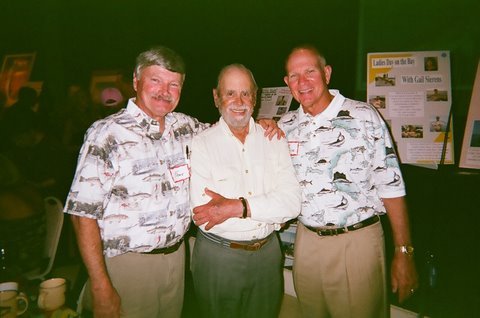By FRANK SARGEANT fsargean@tampabay.rr.com
Published: Jun 6, 2003
Aaron Adams admits to being an angler before he was a scientist. In fact, it’s likely that his love of fishing pushed him into marine science, and he earned a Ph.D. and landed a job with Mote Marine. That might be the reason Adams sounds more like a fisherman than a scientist when he makes a presentation – and why anglers find the information he provides so useful. Adams has just completed his first book for the consumer market, “The Fisherman’s Coast,” and some of the contents will give anglers much- needed insight into the habits of their target species. The seasonal movements of snook are one example. Most anglers know that snook spawn in summer at the passes. But exactly when? “Outgoing tides, in the evenings, around the new and full moons,” Adams said. “There’s some spawning at other times, but the aggregations are by far the strongest then.” And where do they go after the spawn, when they seem to disappear? “One type of habitat where anglers rarely look is far back in the estuaries,” Adams said. “I’ve found 30-inch fish and larger in little creeks you could barely get into in a canoe, and sometimes in places you had to cut your way in with a machete.” Adams said some big snook head to offshore reefs, and many move to deep canals, piers and bridges for much of the year. Big reds and trout sometimes can be found with your ears, he said. “On calm summer evenings around the new and full moons, you can sometimes hear the male redfish and trout drumming to attract mates,” Adams said. “It’s a very soft, low sound, but not that hard to hear once you’re aware of what to listen for.” Sea Grasses Are A Clue The different types of sea grasses also can tip off anglers to good locations, Adams said. “Turtle grass has to be submerged at all times to thrive, but shoal grass can tolerate being exposed, so it grows in shallower water,” Adams said. “As with animals that live on land, fish like that seam where the two types of habitat meet.” Widgeon grass, which grows in very low salinity in coastal rivers and bays, seems to have a special attraction for redfish during the dry season, Adams said. Within all the grass areas, he suggests fishing open patches, which he says predators use as their “killing fields.” “It’s hard for a trout to catch a baitfish or a shrimp in continuous grass, but when they venture across a sand hole they’re exposed, so the fish tend to hide in the grass at the edges and then rush out to attack,” he said. Adams said he also looks for black mangrove roots, which look like pencils sticking out of the water, as good spots for redfish on high falling tides. “Reds love to push back into black mangroves looking for fiddler crabs on high tide, and then they come back out to the edge as the water falls, so that’s where the angler has his best shot at them,” he said. He also said the color of the water affects the color of the baitfish in an area. “In black backwaters, the baits tend to be killifish, mojarra and mangrove crabs, and those are all dark-colored in that water, so it makes sense to use a brown, copper or gold lure,” he said, “while out along the beaches the baits are white or silver or pale green, so I go with those colors in lures on the outside.” Following The Flow When it comes to tidal creeks, Adams says snook and reds sometimes follow the flow, feeding progressively farther into the creek on the rise but staying in water that barely covers their backs so that they have a predatory advantage, basically hunting in two dimensions instead of three. On the beaches, he says there’s good summer snook fishing throughout the Bay area, but most of it is behind the typical angler. “Most anglers wade out to their waist and then cast as far seaward as they can,” Adams said. “But most of the snook will be right along the sand edge or in that first slough, because that’s where feeding is easiest for them.” He recommends staying ashore and casting parallel to the beach, with the best action typically at dawn, dusk and after dark. He also said that in some areas, holes through the first bar cause runouts, which can be very pronounced at certain tide levels. When the runout is strong, fish will hang in the flow, he said. And when it comes to fishing oyster bars, Adams also has a strategy. “A lot of bars sit across the main current, and the water flowing around the ends cause a `scour’ or sand hole at one or both ends,” he said. “Fish get in those holes as the water falls, because the last baits coming out with the tide have to go right over their heads.” On rising water, on the other hand, he suggests fishing in the eddies that form behind the bar, another likely spot for predators. “Pay very close attention to the way the habitat changes with the tides,” he said, “and you’ll catch a lot more fish.” Aaron Adams’ 288-page book will cost $19.95, from Stackpole Books; www.stackpolebooks.com
- Jay Mastry - March 26, 2024
- Captains Corner, Gorta - March 23, 2024
- Dave Zalewski - March 12, 2024











